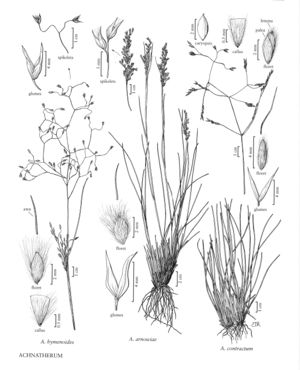Difference between revisions of "Achnatherum hymenoides"
FNA>Volume Importer |
FNA>Volume Importer |
||
| Line 23: | Line 23: | ||
-->{{Treatment/Body | -->{{Treatment/Body | ||
|distribution=Colo.;N.Mex.;Tex.;Utah;Calif.;Minn.;Kans.;N.Dak.;Nebr.;Okla.;S.Dak.;Oreg.;Mont.;Alta.;B.C.;Man.;Sask.;Yukon;Ark.;Wyo.;Wash.;Ariz.;Idaho;Nev. | |distribution=Colo.;N.Mex.;Tex.;Utah;Calif.;Minn.;Kans.;N.Dak.;Nebr.;Okla.;S.Dak.;Oreg.;Mont.;Alta.;B.C.;Man.;Sask.;Yukon;Ark.;Wyo.;Wash.;Ariz.;Idaho;Nev. | ||
| − | |discussion=<p | + | |discussion=<p>Achnatherum hymenoides grows in dry, well-drained soils, primarily in the western part of the Flora region and northern Mexico. Specimens from further east may be introduced; it is unknown whether they have persisted. The roots of A. hymenoides are often surrounded by a rhizosheath formed by mucilaginous secretions to which soil particles attach. This rhizosheath harbors nitrogen-fixing organisms that probably contribute to the success of the species as a colonizer.</p><!-- |
| − | --><p>Native Americans used the seeds of | + | --><p>Native Americans used the seeds of Achnatherum hymenoides for food. It is also one of the most palatable native grasses for livestock. Several cultivars have been developed for use in restoration work, and it is becoming increasingly available for use as an ornamental.</p><!-- |
| − | --><p | + | --><p>Achnatherum hymenoides forms natural hybrids with other members of the Stipeae. See discussion on p. 142.</p> |
|tables= | |tables= | ||
|references= | |references= | ||
| Line 41: | Line 41: | ||
|basionyms= | |basionyms= | ||
|family=Poaceae | |family=Poaceae | ||
| + | |illustrator=Cindy Roché | ||
|distribution=Colo.;N.Mex.;Tex.;Utah;Calif.;Minn.;Kans.;N.Dak.;Nebr.;Okla.;S.Dak.;Oreg.;Mont.;Alta.;B.C.;Man.;Sask.;Yukon;Ark.;Wyo.;Wash.;Ariz.;Idaho;Nev. | |distribution=Colo.;N.Mex.;Tex.;Utah;Calif.;Minn.;Kans.;N.Dak.;Nebr.;Okla.;S.Dak.;Oreg.;Mont.;Alta.;B.C.;Man.;Sask.;Yukon;Ark.;Wyo.;Wash.;Ariz.;Idaho;Nev. | ||
|reference=None | |reference=None | ||
| Line 46: | Line 47: | ||
|publication year= | |publication year= | ||
|special status= | |special status= | ||
| − | |source xml=https:// | + | |source xml=https://bibilujan@bitbucket.org/aafc-mbb/fna-data-curation.git/src/314eb390f968962f596ae85f506b4b3db8683b1b/coarse_grained_fna_xml/V24/V24_187.xml |
|subfamily=Poaceae subfam. Pooideae | |subfamily=Poaceae subfam. Pooideae | ||
|tribe=Poaceae tribe Stipeae | |tribe=Poaceae tribe Stipeae | ||
Revision as of 16:06, 30 October 2019
Plants tightly cespitose, not rhizomatous. Culms 25-70 cm tall, 0.7-1.3 mm thick, glabrous or partly scabridulous; nodes 3-4. Sheaths glabrous or scabridulous, sometimes puberulent on the distal margins, hairs to 0.8 mm; collars glabrous, sometimes with tufts of hair on the sides, hairs to 1 mm; basal ligules 1.5-4 mm, hyaline, glabrous, acute; upper ligules to 2 mm; blades usually convolute, 0.1-1 mm in diameter, abaxial surfaces smooth or scabridulous, adaxial surfaces pubescent. Panicles 9-20 cm long, 8-14 cm wide; branches ascending to strongly divergent, longest branches 3-15 cm; pedicels paired, conspicuously divaricate, shorter pedicels in each pair usually at least 1/2 as long as the longer pedicels. Glumes subequal, 5-9 mm long, 0.8-2 mm wide, saccate below, puberulent, hairs about 0.1 mm, tapering above midlength, apices acuminate; lower glumes 5-veined at the base, 3-veined at midlength; upper glumes 5-7-veined at the base; florets 3-4.5 mm long, 1-2 mm thick, obovoid; calluses 0.4-1 mm, sharp; lemmas indurate, densely and evenly pilose, hairs 2.5-6 mm, easily rubbed off, apices not lobed; awns 3-6 mm, rapidly deciduous, not geniculate, scabrous; paleas subequal to the lemmas in length and texture, glabrous, apices pinched; anthers 1.5-2 mm, penicillate, dehiscent, well-filled. Caryopses 2-3 mm. 2n = 46, 48.
Distribution
Colo., N.Mex., Tex., Utah, Calif., Minn., Kans., N.Dak., Nebr., Okla., S.Dak., Oreg., Mont., Alta., B.C., Man., Sask., Yukon, Ark., Wyo., Wash., Ariz., Idaho, Nev.
Discussion
Achnatherum hymenoides grows in dry, well-drained soils, primarily in the western part of the Flora region and northern Mexico. Specimens from further east may be introduced; it is unknown whether they have persisted. The roots of A. hymenoides are often surrounded by a rhizosheath formed by mucilaginous secretions to which soil particles attach. This rhizosheath harbors nitrogen-fixing organisms that probably contribute to the success of the species as a colonizer.
Native Americans used the seeds of Achnatherum hymenoides for food. It is also one of the most palatable native grasses for livestock. Several cultivars have been developed for use in restoration work, and it is becoming increasingly available for use as an ornamental.
Achnatherum hymenoides forms natural hybrids with other members of the Stipeae. See discussion on p. 142.
Selected References
None.
